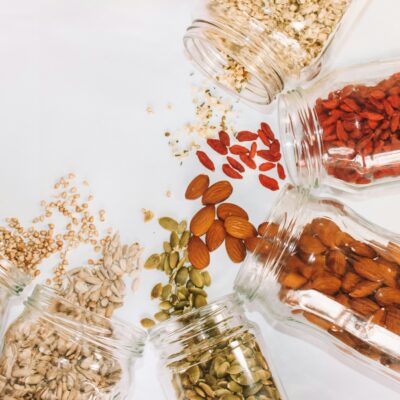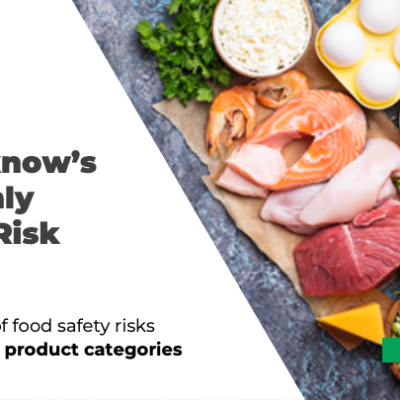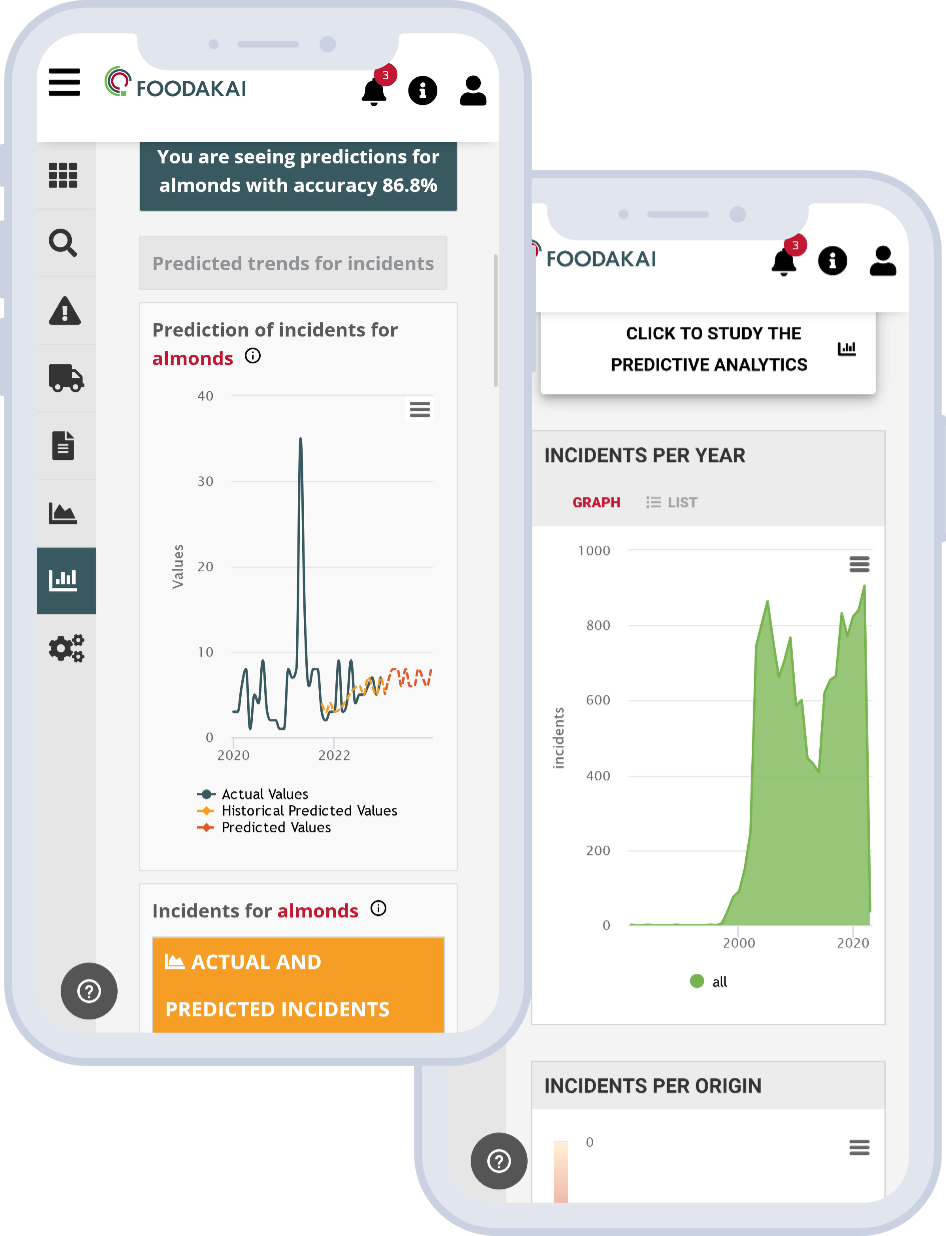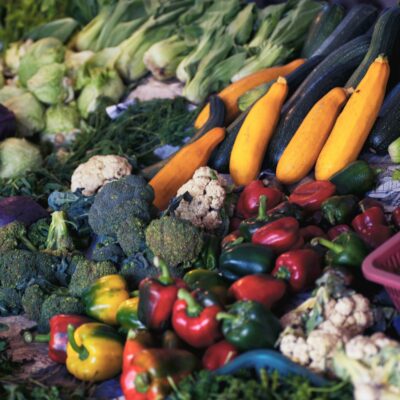
Monthly Forecasts Review: February
Welcome back to our Monthly Forecasts Review, the article series where we examine the performance of our forecast’s trends for the number of incidents in 10 key food categories for the past month, February. Additionally, we are reviewing the performance of our hazard trend forecasting module for the top 5 hazard categories (Biological, Chemical, Foreign Bodies, Allergens & Fraud), focusing deeper on Biological Hazard Forecasts.
Our methodology
Comparing the forecasted incidents trend for each food product category and hazards, as extracted by FOODAKAI, against the actual recorded number of incidents for these in the past month.
FOODAKAΙ is the AI-powered & predictive data analytics platform that collects, harmonizes and correlates data from approximately 200 public authority sources, which are then curated by food safety experts. Through continuously trained and updated AI models, FOODAKAI produces high-accuracy incident forecast trends for all known ingredients, raw materials and hazards, which can be utilized to inform the risk mitigation strategies of food & beverage companies worldwide.
For our previous edition, read here.
Key Food Categories Forecasts Review
To start with, let’s take a look at the overall incidents trend forecasts in 10 Key Food Categories for February.
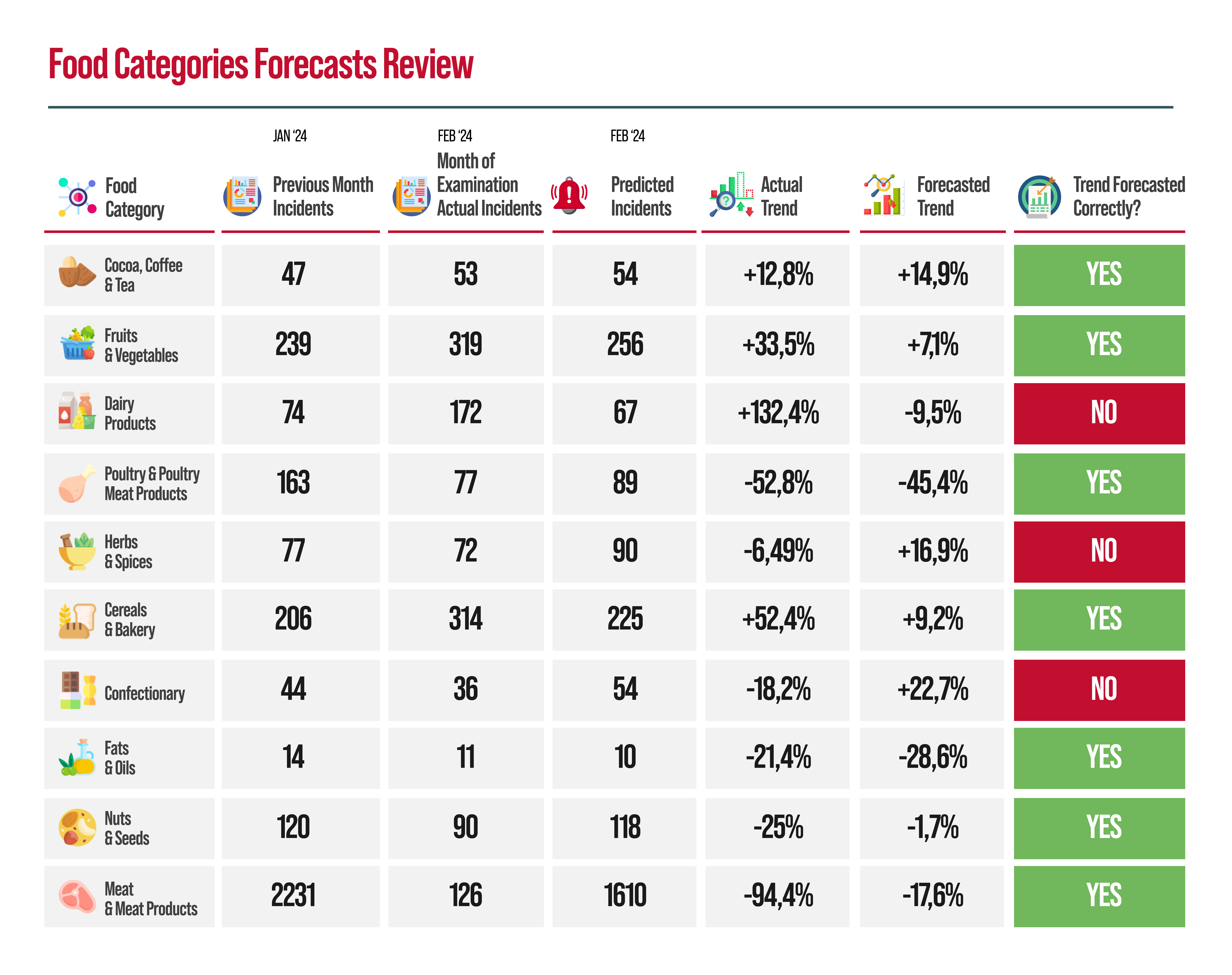
As illustrated above the FOODAKAI platform correctly forecasted the incidents trend for 7 out of the 10 food categories, namely Cocoa, Coffee & Tea, Fruits & Vegetables, Poultry & Poultry Meat products, Cereals & Bakery, Fats & Oils, Nuts & Seeds and Meat & Meat Products. In the Dairy products, Herbs & Spices and Confectionary food categories the platform didn’t forecast the trends correctly.
Highlights:
- In the Cocoa, Coffee & Tea, FOODAKAI forecasted the increasing incidents trend with great accuracy, indicating 54 incidents compared to the 53 that were recorded, a 2.1 point difference.
- In the Fruits & Vegetables, Cereals & Bakery and Nuts & Seeds product categories while the platform forecasted the increasing trend successfully, it didn’t anticipate the level of increase. With massive amounts of data in our disposal, the relevant algorithms are continuously being trained and improved to increase the efficiency and accuracy of their forecasting results.
- In the Diary products category, the platform didn’t forecast the increasing trend which was very high but anticipated a slight decrease. A number of incident peaks during the month contributed to that, highlighting the need for continuous update of the AI-powered forecasting algorithms.
- In the Poultry & Poultry Meat products accurately forecasted the decreasing trend of incidents, anticipating a large decrease in the number for incidents of 52.8% against an actual decrease of 45.4%.
- In the Confectionary products category, the platform didn’t forecast the decrease in the number of incidents due to the difficulty in fitting a robust model for the category due to the lack of data and seasonality in the product category.
- For the Fats & Oilis product category, FOODAKAI, forecasted with exceptional accuracy the decreasing trend of 28.6% versus the actual of 21.4% with 10 incidents over the 11 that were recorded.
- In the Meat & Meat products category, FOODAKAI detected a decreasing trend. While there seems to be a large difference between the predicted and actual level of decrease, this can be attributed to an ongoing open issue regarding one of the prime sources that delayed publishing the relevant incident reports for packaging defect incidents for the product category.
Hazard & Risk Categories Forecasts Review
Following the overall incidents trends for the Top 10 categories, we examined the performance of the hazard trend forecasts, meaning the forecasted incidents trend according to hazard and risk type.
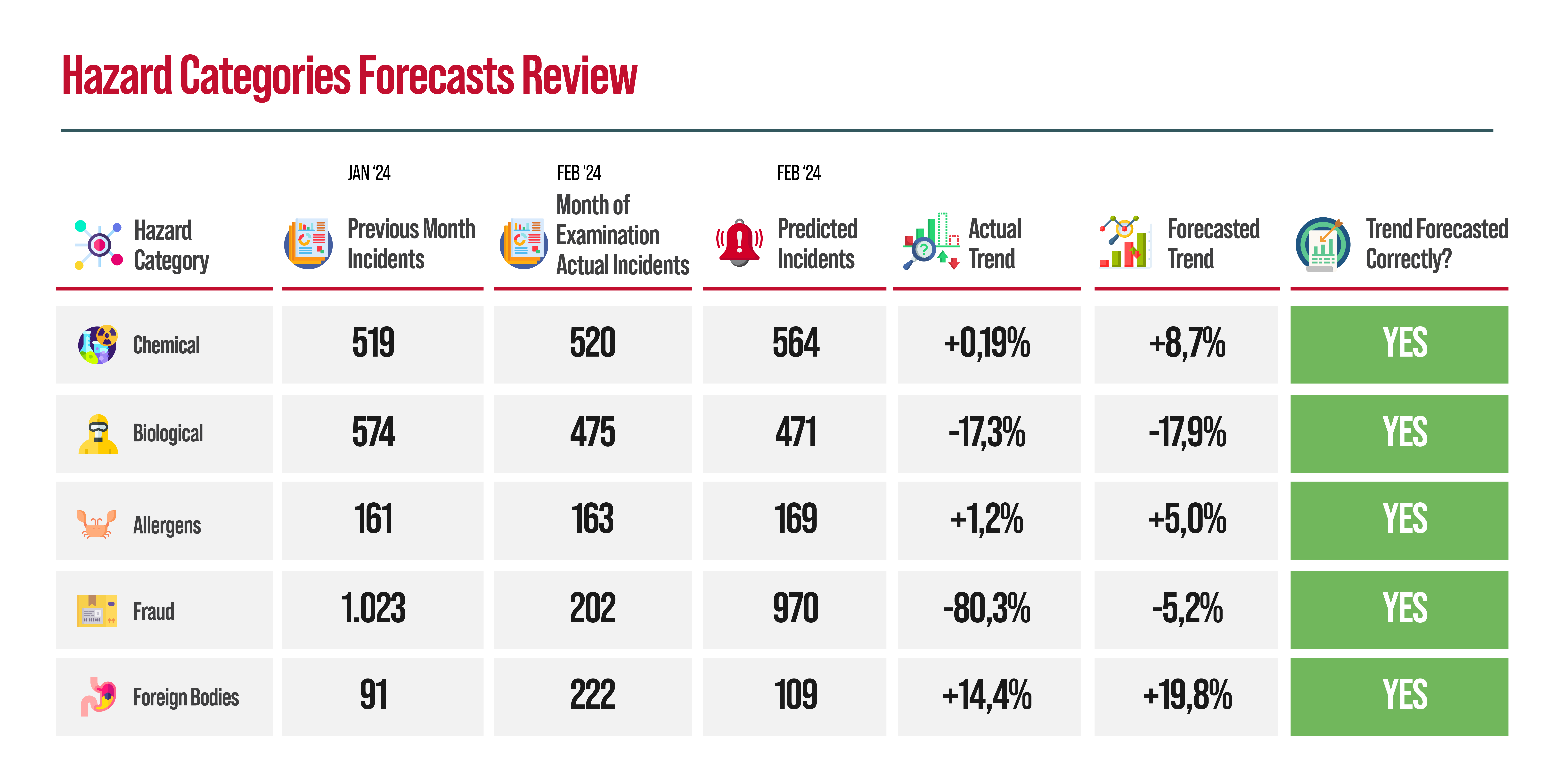
FOODAKAI successfully forecasted the incidents trend in all 5 Hazard and Risk types: Chemical, Foreign Bodies, Biological, Allergens & Fraud. It didn’t forecast the trend for Food Fraud incidents.
Highlights:
- For incidents attributed to Chemical Hazards, the platform forecasted an 8.7% increase compared to the actual 0.19% decrease, with 520 incidents recorded over the projected 564.
- For Biological & Allergen Hazard incidents, FOODAKAI forecasted with extreme accuracy the decreasing and increasing trends respectively:
- 17,9% forecasted over 17.3% actual trend for Biological Hazards
- 5.0% forecasted over 1.2% actual trend for Biological Hazards
- Regarding incidents attributed to Food Fraud and Foreign Bodies, FOODAKAI, forecasted the increasing trend, however not the level of increase.
Biological Hazards Forecasts Per Food Category
In this last section, we dived deeper into the forecasted vs the actual trends for incidents associated with biological hazards in these 10 Food Categories.
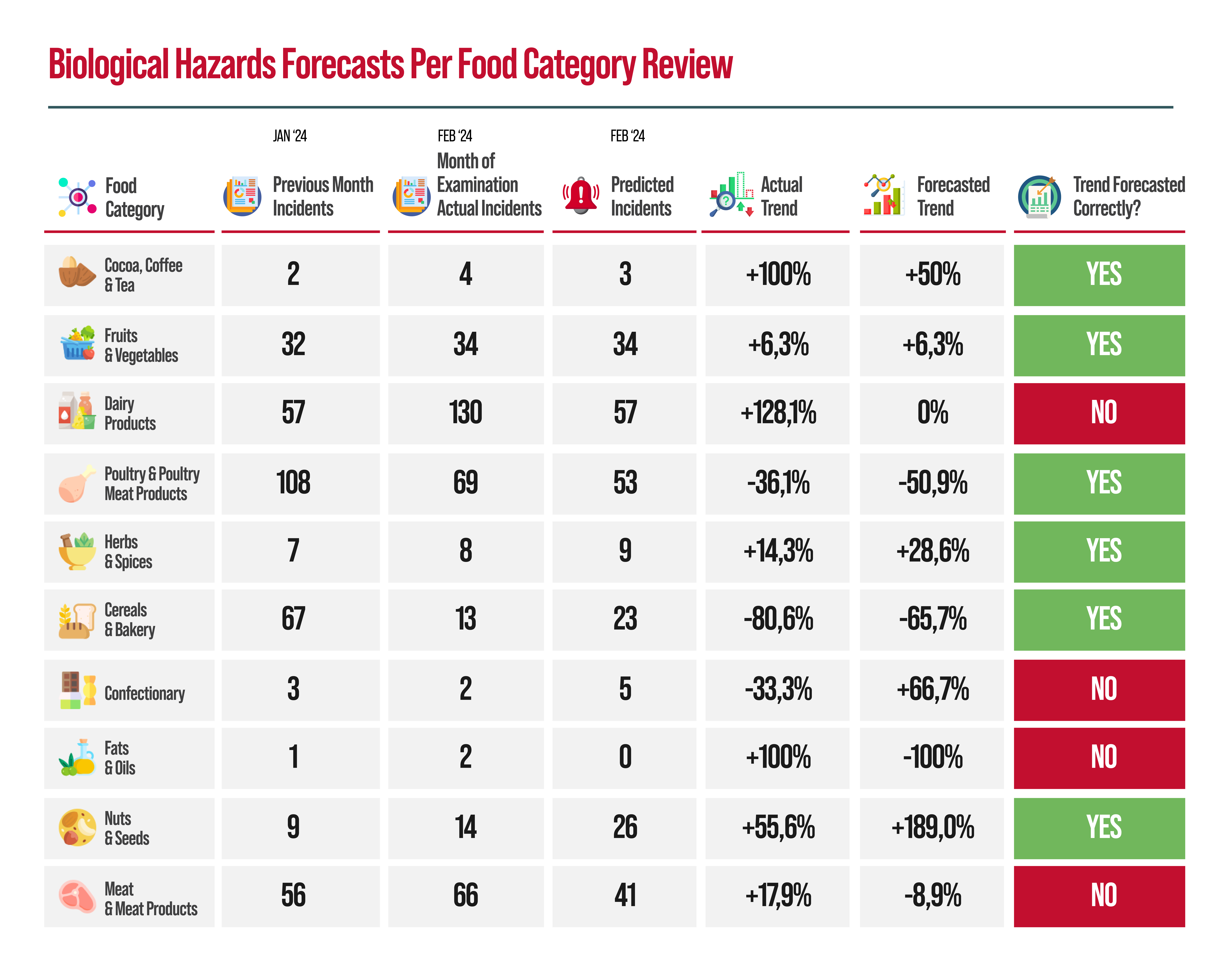
The platform correctly forecasted the biological hazard incidents in 6 out of the 10 food categories, Cocoa, Coffee & Tea, Fruits & Vegetables, Poultry & Poultry Meat Products, Herbs & Spices, Cereals & Bakery and Nuts & Seed products. For the Dairy Products, Confectionary, Fat & Oils it didn’t correctly forecast the incidents trend. For the Fats & Oils Category no incidents were recorded.
Highlight:
- Regarding Biological Hazards in Fruits & Vegetables, the platform forecasted the exact trend (6.3% increase) and number of incidents, 34, for the past month.
- For Cereal & Bakery products Biological Incidents the platform correctly anticipated a decrease in the number of incidents but as slightly lower decrease than what was recorded (65.7% instead of 80.6%).
- For Biological incidents in Dairy Products it forecasted neither a decrease nor an increase, which was far from the recorded peak that lead to an 128.1% increase and 130 incidents. Continuous validation and updates of the algorithm for that category will allow us to forecast incidents with more accuracy in the future.
- In the Cocoa, Coffee & Tea product category, FOODAKAI forecasted half the increase in the number of incidents to the actual recorded increase. However, the limited number of data/incidents didn’t allow us to have a compound validation of the forecasts.
- In the Herbs & Spices and Nuts & Seeds product categories, the platform correctly anticipated a higher level of increase than the one that was recorded. However, in the Herbs & Spices product category, as with the above product category the limited number of data/incidents didn’t allow us to have a compound validation of the forecasts.
- In the Poultry & Poultry Meat Products category, the platform successfully forecasted an increase, although higher level of increase 50.9% compared to the actual 36.1%.
- In both Confectionary and Fat & Oils products regarding biological incidents the platform forecasted an opposite trend
- Increase for Confectionary when there was decrease, due to the lack in the number of data and seasonality as discussed earlier.
- Decrease in Fats & Oils when there was an increase. Also, the number of incidents set limitations to how successfully the result can be validated.
- Finally, in the Meat & Meat Products category, the ongoing issue with the packaging defect incidents sources delaying the publication of the incidents impacted the number of incidents.
With new recalls announced everyday food & beverage companies need to vigilant and be able to anticipate new and emerging risks in their supply chains. Through highly accurate forecasts based on continuously trained AI models and algorithms, food companies can supercharge their risk mitigation efforts, moving from a reactive to a proactive stance.
Want to learn more about how you can benefit from such forecasts?
Schedule a call here.
Want to receive helpful food safety intelligence in your inbox?
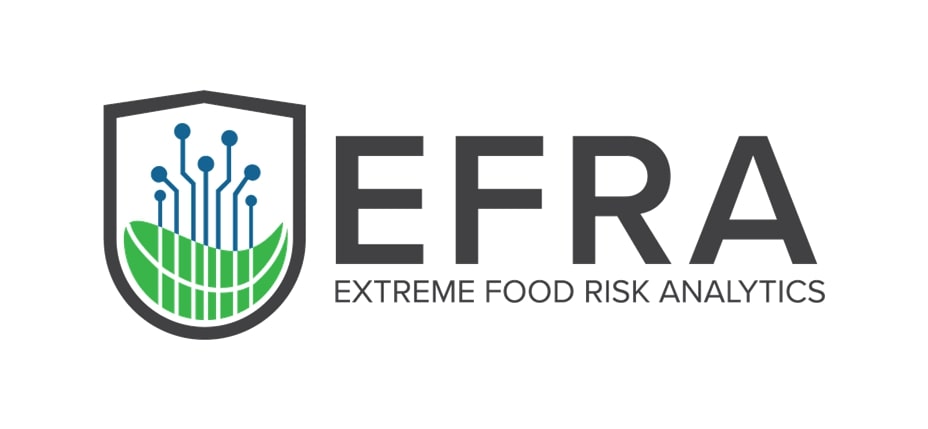 Funding for this research has been provided by the European Union’s Horizon Europe research and innovation programme EFRA (Grant Agreement Number 101093026). Funded by the European Union. Views and opinions expressed are however those of the author(s) only and do not necessarily reflect those of the European Union or European Commission-EU. Neither the European Union nor the granting authority can be held responsible for them.
Funding for this research has been provided by the European Union’s Horizon Europe research and innovation programme EFRA (Grant Agreement Number 101093026). Funded by the European Union. Views and opinions expressed are however those of the author(s) only and do not necessarily reflect those of the European Union or European Commission-EU. Neither the European Union nor the granting authority can be held responsible for them.


